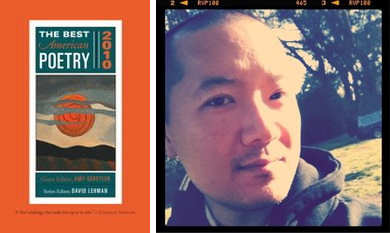
We usually don’t post on the weekend, but I’m posting today because we wanted to let you know about an awesome series that LR Contributor and Kartika Review poetry editor Kenji C. Liu is curating this week at The Best American Poetry Blog, in honor of APIA Heritage Month. Kenji has invited me (Iris), along with 3 other editors and self-identified writers of Asian American poetry—Patricia Ikeda, Gerald Maa of AALR, and Barbara Jane Reyes—to contribute posts to the series, and it’s been both an honor and a pleasure to be able to work with him.
Kenji kicked off the series today with this awesome introductory post, in which he discusses both the difficulty and the utility of curating poetry through the lens of the “Asian American” label, and describes his thoughts about the importance of the conversation that will take place throughout the week. (He plans to spotlight the work of several Asian American poets who have come to their vocations through alternative/non-standard/non-MFA routes).
He is clear to note that the purpose of these posts is not to engage in a debate about the worth of the MFA (indeed, he acknowledges that the MFA is a valuable resource), but to “bring . . . greater attention” to APIA poets who have not gone that route, in “recogniz[ing] that a formal graduate education in creative writing often provides resources and networking opportunities that may not be as easily accessible for others.”
I’ll post to the LR blog again when my contribution, which will focus on dual-discipline LR contributors Aryanil Mukherjee (who’s an engineering mathematician) and Kimberly Alidio (whose graduate training is in History) goes live, but in the meantime, we invite you to continue checking back with the Best American Poetry Blog throughout the week to watch our discussion unfold.
Congratulations to Kenji, and many thanks to him for allowing us to be a part of this important conversation.
To follow the series, “A Week of Asian Pacific Islander American Poetry,” please visit The Best American Poetry Blog.
* * *
Kenji C. Liu’s poem “A Son Writes Back” appeared in Issue 2 of Lantern Review.
—
